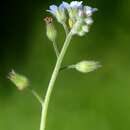en
names in breadcrumbs


Myosotis (/ˌmaɪəˈsoʊtɪs/ MY-ə-SOH-tiss[2]) is a genus of flowering plants in the family Boraginaceae. The name comes from the Ancient Greek μυοσωτίς "mouse's ear", which the foliage is thought to resemble.[3] In the Northern Hemisphere, they are colloquially known as forget-me-nots[4] or scorpion grasses. Myosotis alpestris is the official flower of Alaska[5] and Dalsland, Sweden. Plants of the genus are commonly confused with Chatham Islands' forget-me-nots, which belong to the related genus Myosotidium.
The genus was originally described by Carl Linnaeus. The type species is Myosotis scorpioides. Myosotis species are annual or perennial, herbaceous, flowering plants with pentamerous actinomorphic flowers with five sepals and petals.[3] Flowers are typically 1 cm in diameter or less, flatly faced, coloured blue, pink, white or yellow with yellow centres and borne on scorpioid cymes. Their foliage is alternate, and their roots are generally diffuse. They typically flower in spring or soon after the melting of snow in alpine ecosystems.
The seeds are contained in small, tulip-shaped pods along the stem to the flower. The pods attach to clothing when brushed against and eventually fall off, leaving the small seed within the pod to germinate elsewhere. Seeds can be collected by placing a sheet of paper under stems and shaking the seed pods onto the paper.
Myosotis scorpioides is colloquially called scorpion grass because of the spiraling curvature of its inflorescence.[3]
The genus is largely restricted to western Eurasia, with about 60 confirmed species, and New Zealand with around 40 endemic species.[6] A few species occur elsewhere, including North America, South America, and Papua New Guinea.[4] Despite this, Myosotis species are now common throughout temperate latitudes because of the introduction of cultivars and alien species. Many are popular in horticulture. They prefer moist habitats. In locales where they are not native, they frequently escape to wetlands and riverbanks. Only those native to the Northern Hemisphere are colloquially called "forget-me-nots".
One or two European species, especially Myosotis sylvatica, the "woodland" forget-me-not, have been introduced into most of the temperate regions of Europe, Asia, and the Americas.
Genetic analysis indicates that the genus originated in the Northern Hemisphere, and that species native to New Zealand, Australia, New Guinea, and South America form a lineage of closely related species that are likely derived from a single dispersal event to the Southern Hemisphere.[4][7]

Myosotis species are food for the larvae of some Lepidoptera species, including the setaceous Hebrew character. Many of the species in New Zealand are threatened.[8]
Of more than 510 recorded species names, only 152 species are presently accepted, listed below.[9] The remainder are either synonyms or hybrids of presently accepted or proposed names.[10][11]
The small, blue forget-me-not flower was first used by the Grand Lodge Zur Sonne, in 1926, as a Masonic emblem at the annual convention in Bremen, Germany. In 1938, a forget-me-not badge—made by the same factory as the Masonic badge—was chosen for the annual Nazi Party Winterhilfswerk, the annual charity drive of the National Socialist People's Welfare, the welfare branch of the Nazi party. This coincidence enabled Freemasons to wear the forget-me-not badge as a secret sign of membership.[12][13]
After World War II, the forget-me-not flower was used again as a Masonic emblem in 1948 at the first Annual Convention of the United Grand Lodges of Germany. The badge is now worn in the coat lapel by Freemasons around the world to remember all who suffered in the name of Freemasonry, especially those during the Nazi era.[14]
The flower is also used as a symbol of remembrance by the people of Newfoundland and Labrador. It is used to commemorate those from the province who were killed in the First World War, and worn around July 1.
It is also used in Germany to commemorate the fallen soldiers of the world wars in a similar manner to the use of remembrance poppies in the UK.
The flower is also the symbol for the Armenian genocide's 100th anniversary. The design of the flower is a black dot symbolising the past, and the suffering of Armenian people. The light purple appendages symbolise the present, and unity of Armenians. The five purple petals symbolise the future, and the five continents to which Armenians escaped. The yellow in the centre symbolises eternity, and the Tsitsernakaberd itself symbolises the 12 provinces lost to Turkey.[15]
In Lithuania, the flower has become one of the symbols for the commemoration of the January events of 1991.[16]
In the Netherlands, the forget-me-not has become a symbol for Alzheimer Nederland, a foundation advocating for people suffering from dementia.
In New Zealand, the forget-me-not is the symbol for Alzheimers New Zealand, the foundation advocating for people suffering from Alzheimer's disease and dementia.[17]
In history of art, the forget-me-not is used to remember loved ones who have died, so is very common in funerary portraits.
Myosotis (/ˌmaɪəˈsoʊtɪs/ MY-ə-SOH-tiss) is a genus of flowering plants in the family Boraginaceae. The name comes from the Ancient Greek μυοσωτίς "mouse's ear", which the foliage is thought to resemble. In the Northern Hemisphere, they are colloquially known as forget-me-nots or scorpion grasses. Myosotis alpestris is the official flower of Alaska and Dalsland, Sweden. Plants of the genus are commonly confused with Chatham Islands' forget-me-nots, which belong to the related genus Myosotidium.